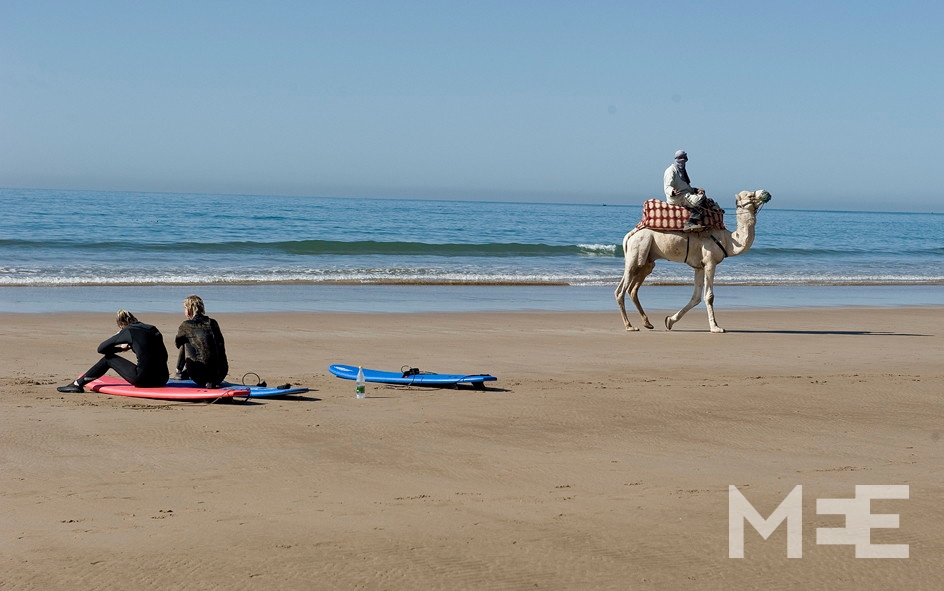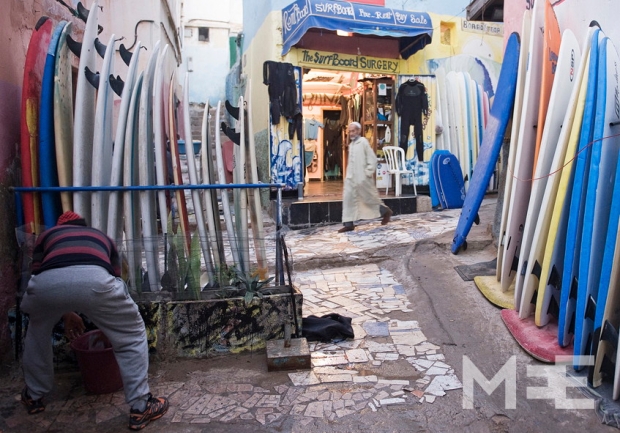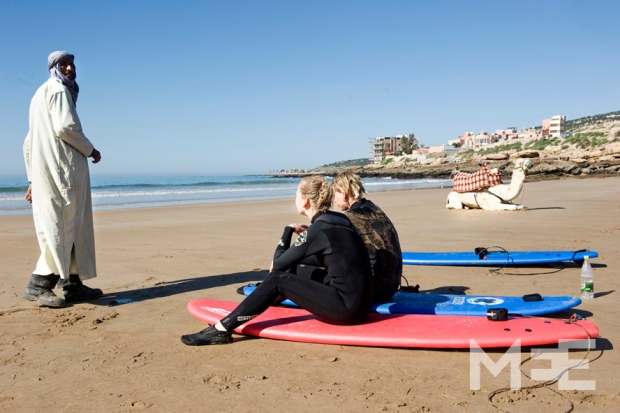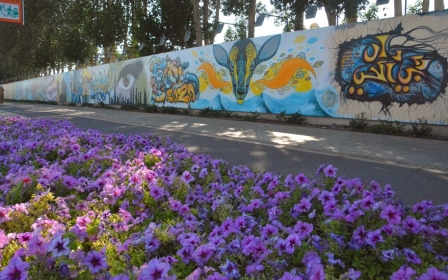Morocco's Taghazout – from fishing village to surfers hub

TAGHAZOUT, Morocco - Every morning just after dawn prayers, Mohamed Rami and three of his colleagues carry his boat over the pebbled beach of this small town on the Moroccan coast and lay it in the Atlantic Ocean. As the vessel touches the water, the 37-year-old captain jumps in for a day of fishing. In March when it’s high season, about 60 boats go out to sea, but in winter only around 20 of the small boats head for the fishing grounds a few miles offshore.
If it’s not too dark, on their right they’ll see young men and women, surfboards under their arms, jumping from rock to rock towards Anchor Point. There, at Morocco’s most famous surfspot, waves can reach up to 15 feet. “We watch them, but fishermen don’t work with surfers,” Rami says. “Most of us don’t speak English, and rarely French. It’s two different worlds.” Another fisherman adds: “Surfers like high waves. We don’t.”
The Moroccan town of Taghazout is a cool, relaxed place, just north of Agadir on the Atlantic coast. It used to be a poor fishing village, but over time, it began to attract surfers from across the world. The main street is a stretch of cafes and surfshops, buzzing with foreign women in shorts and men with long hair and week-old beards. Locals fix damaged surfboards and sell everything that foreign tourists might want to buy - except alcohol. Hostels organise regular booze-runs to a nearby town to stock up on beer for sale in-house.
No buildings
This Berber village has reinvented itself in recent decades. It attracted waves of hippies in the 70s and in later years vans full of surfers. From the early 90s, Taghazout exploded with tourism.
“Without tourists Taghazout would be nothing, just another fishing town trying to get by,” says Hassan Aït Ahmed (44). He is gutting the catch of the day in the small fishmarket. Tourists and locals stroll up to his steel table to buy calamaris or mullet. He smiles: “So yes, you could say I work in tourism, like most people here. This place is busy four or five months a year, during high season. For us it’s good. The rest of the time there’s not much life here.”
Tourism provides an income for most of the local youth these days. They work in the hostels, cafes, craft-shops or as guides. One of them is Yazid Kanane (25), a manager at the English-run Surf Maroc, probably the biggest surf and yoga enterprise in town. Kanane is the transport manager; he directs surfers to the beaches and arranges their transport.
Surf Maroc started 11 years ago and now has four or five locations, where it can host up to 100 tourists. “I’ve been camping here with my parents all my life. Where we are now, there were no buildings at all,” says Kanane. But the buildings came to meet the changing demands of the customers.
“Surf Maroc introduced the yoga element in Taghazout,” Kanane says proudly. He adds: “Mainly for foreigners, since Moroccans hardly ever do yoga here.”
The combination of surfing and yoga makes sense, according to British instructor Jenni Crowther. She just ended a class of eight pupils. “I always look at the waves to plan my lessons. Today there was a calm sea, so the guests were not too tired. In that case, my lessons can be quite dynamic. If it’s likely the surfers come in completely knackered from all the paddling, I’ll do a more relaxed hour, with extra attention to the shoulders.”
Fading charm
But Taghazout’s transformation to a surfers’ paradise has come at a cost. As new money floods into the village, many fear that it could destroy the charm that originally made it a haven for travellers.
Between Taghazout and the neighbouring coastal town of Tamraght, stretches of construction sites line the coast. The aim is to build a massive tourist resort - albeit in a sustainable way with energy-efficient technology and its own water facility.
The resort is scheduled to be open for tourists in 2017, with 7,500 beds and providing 20,000 jobs for locals. It will have two large golf courses, one of which is already in use in the hills overlooking the bay, and artisan-shops and a fishmarket in the new medina. Hassan Ait Ahmed fears the worst. “It is going to be very big, and we’re afraid it will cost Taghazout a lot of tourists. For us, the resort is not good.”
Some tourists think the same; Taghazout is changing. One lazy Sunday afternoon, Germans Tina Karger (24) and Melle Jahn (34) sat on their boards on the beach. They travel old-school, discovering Morocco in a 37-year-old van. Jahn was in Morocco 10 years ago, and has noticed how things have changed. Better roads, more security, everybody has mobile phones. But does he like Taghazout? He frowns. “It’s impossible not to be a tourist here and I don’t like that.”
Karger adds: “I was here a year ago. When you got out of your car then, one person might ask you if you wanted a place to sleep. Now five people will jump you.”
Tricky thing
Elsa Goerlinger, an activist with the Surfrider Foundation, warns that the growth of Taghazout also came with environmental costs and she fears the resort might have a deep impact. “Two golf courses in a place where it rains twice a year. How can that be sustainable?”
Surfrider Foundation educates locals on the importance of a clean coastline and sustainability. She took Middle East Eye on a tour in Taghazout, past semi-dry riverbeds filled with plastic and garbage. Sewers from the houses splash their dirty water there, it flows past hotels into the sea, taking the plastic with it. “We took samples along the coast and had them analysed. The Thagazout sample went way-high in the charts. I never surf here.”
Indeed, several fisherman complained about the stench on the beach. Laying new drainage for the village is expensive, Goerlinger admits, but she says it is necessary. “We heard there are plans to build a cleaning station, but it isn’t there yet.”
Construction on the coastline is a tricky thing. Before you know it, the currents will be influenced and that might have its effect on the waves. “Anchor Point is the surf spot people come for. If the waves there disappear because of construction on the coastline, Thagazout will die.”
A 57-year-old restauranteur, Hussein Mara is ambivalent about the changes in his town. When the restaurant opened in 1988, guests on the terrace had a clear view on the ocean, he says. Now, that view has gone. “The village started out with 200 houses, and all families were fishermen. Now there are four times as many houses, I think. And only about 60 or 70 fishing boats. In high season, hundreds of tourists come here every day and that is good. Taghazout went from a poor village to being a richer town.”
He shuffles off to prepare the restaurant, putting candles on the tables and turning up the music. The first song that comes out of the stereo is “California Dreaming,” followed by “Don’t You Want Somebody to Love,” and “Good Morning Starshine.” The spirit of the hippies that used to flock here lingers in the evening air, but it’s fading.
Middle East Eye propose une couverture et une analyse indépendantes et incomparables du Moyen-Orient, de l’Afrique du Nord et d’autres régions du monde. Pour en savoir plus sur la reprise de ce contenu et les frais qui s’appliquent, veuillez remplir ce formulaire [en anglais]. Pour en savoir plus sur MEE, cliquez ici [en anglais].







